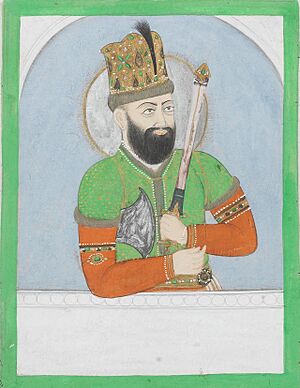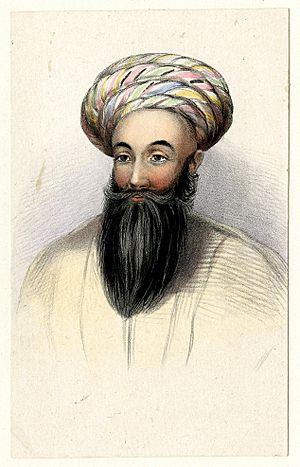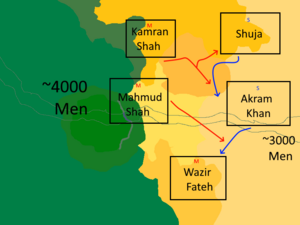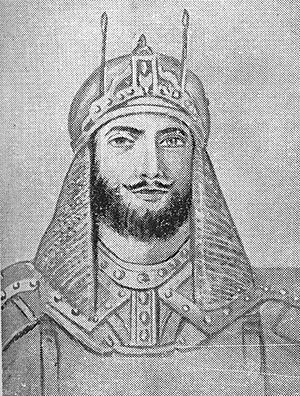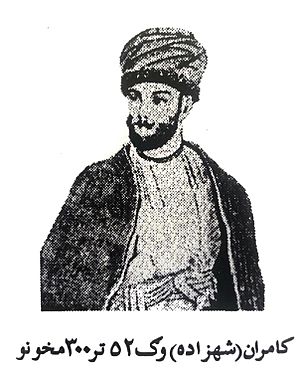Mahmud Shah Durrani facts for kids
Quick facts for kids Mahmud Shah Durraniمحمود شاه درانی |
|||||
|---|---|---|---|---|---|
| Shah of the Durrani Empire | |||||
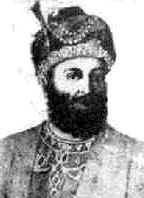 |
|||||
| Emperor of the Durrani Empire | |||||
| 1st reign | 25 July 1801 – 13 July 1803 | ||||
| Predecessor | Zaman Shah Durrani | ||||
| Successor | Shuja Shah Durrani | ||||
| 2nd reign | 3 May 1809 – 1818 | ||||
| Predecessor | Zaman Shah Durrani Shah Shuja Durrani |
||||
| Successor | Shah Shuja Durrani Ali Shah Durrani |
||||
| Born | 1769 | ||||
| Died | 18 April 1829 (aged 60) | ||||
| Issue | Kamran Shah Durrani | ||||
|
|||||
| Dynasty | Durrani | ||||
| Father | Timur Shah Durrani | ||||
| Mother | unknown Yusufzai lady | ||||
| Religion | Islam | ||||
Mahmud Shah Durrani (born 1769 – died 18 April 1829), also known as Shah Mahmud, was a ruler of the Durrani Empire. He ruled twice: first from 1801 to 1803, and then again from 1809 to 1818. After his second reign, he became the emir (ruler) of Herat from 1818 until his death in 1829. Mahmud Shah was a member of the Sadduzai clan, part of the Popalzai tribe of the Durrani Pashtuns. He was the son of Timur Shah Durrani and the grandson of Ahmad Shah Durrani, who founded the Durrani Empire.
Contents
Early Life and Rule in Herat
Mahmud Shah was born in 1769. He was the second son of Timur Shah Durrani. His father appointed him as the emir of Herat when he was only 8 years old.
When his father, Timur Shah, died in 1793, there was a big fight for who would rule next. Mahmud Shah first sided with his brother Humayun against their older brother, Zaman Shah Durrani. Zaman Shah locked up all his rivals until they agreed to accept him as the new ruler. Mahmud eventually agreed.
Mahmud was allowed to keep ruling Herat, but now he had to obey Zaman Shah. Even so, Mahmud Shah tried to gain more power many times while he was the ruler of Herat.
Zaman Shah's Attack on Herat
In 1795, Zaman Shah Durrani marched to Herat to take full control. He wanted to stop the Persians from taking over lands like Mashad and Herat. Zaman Shah defeated Mahmud Shah near Ghirisk. He then tried to capture Herat.
The city held strong, and the two brothers made a deal. Mahmud Shah would recognize Zaman Shah as the main ruler. In return, Zaman Shah would let Mahmud Shah stay as governor of Herat.
However, Mahmud's son, Kamran Mirza, didn't know about the peace deal. He chased Zaman Shah's retreating army. While Kamran was away, the city's commander revolted and opened the gates to Zaman Shah. Mahmud Shah and Kamran had to escape to Tehran, seeking help from the Persian court.
Mahmud Shah's First Return
Later, the British gave money to the Shah of Persia. They worried that Zaman Shah might unite Muslim rulers in India against them. Seeing this chance, Mahmud Shah and his brother, Firoz Mirza, gathered an army. They marched on Farah and Herat.
They captured Farah and defeated Zaman Shah's son, Qaizar Mirza. They also began to besiege Herat. Zaman Shah had to stop his campaigns in Punjab and return. The Sikhs then took back Lahore.
Even though many in Herat supported Mahmud Shah, Qaizar held out. A trick was played, and Mahmud Shah and Kamran believed they were betrayed. They fled in the middle of the night. Qaizar then attacked and defeated the Persian army besieging Herat.
Mahmud Shah's Second Return
After a powerful leader named Payandah Khan Barakzai was executed, his sons went to the Persian court. They promised to support Mahmud Shah if he tried to take the throne again. Mahmud Shah and Payandah Khan's son, Fateh Khan, gathered an army. Many of them were Barakzai tribesmen.
They marched on Kandahar. Zaman Shah had made many enemies. The governor of Kashmir rebelled and was executed. When Zaman Shah's brother, Saidal Khan, who was defending Kandahar, heard about this, he opened the city gates to Mahmud Shah.
Mahmud Shah then marched towards Ghazni. Zaman Shah returned to Kabul, but left most of his army behind. Mahmud Shah and Zaman Shah finally met for battle near Muqur. Before the fight, a leader named Ahmad Khan joined Mahmud Shah. The Ghilzai tribes also surrounded Zaman Shah's escape route. Zaman Shah's army fell apart, and he fled.
Zaman Shah hid with a local holy man, Mullah Ashiq. But Ashiq secretly told Mahmud Shah where they were. Zaman Shah tried to offer Ashiq money, but it was too late. Zaman Shah was captured, and his eyes were blinded.
First Time as Emperor (1801-1803)
Mahmud Shah marched into Kabul and was declared the King of the Durrani Empire in 1801. Zaman Shah was kept prisoner in the Bala Hissar, Kabul palace.
Challenges to the Empire
When Mahmud Shah became king, the Durrani Empire was in a difficult state. It was divided into many smaller, independent areas. Zaman Shah later escaped from prison and joined his brother, Shuja. They tried to remove Mahmud from power, but Mahmud Shah defeated them.
The ruler of Bukhara also tried to invade Balkh, but Mahmud Shah's army stopped him. A leader named Al-Rahim started a big revolt against Mahmud Shah. He took over Kandahar and attacked Ghazni. Another army marched towards Kabul. Mahmud Shah's forces won both battles. In one battle, they defeated the Tokhi Ghilzais and built a pyramid of skulls to celebrate.
Problems and Unrest
In 1801, a treaty was signed between Britain and Persia. It aimed to stop Afghan expansion. In 1803, the Persians attacked Mashhad, a city important to the Durrani Empire. This news made many Sunni religious leaders in Kabul angry. They started attacks on the Qizilbash and other Shi'a communities in Afghanistan.
These riots were also used to try and reduce the power of the Turkic Qizilbash people. They had a lot of influence in the Durrani Empire. Some people in the Durrani court thought the Qizilbash might side with Persia if Persia attacked Herat. This made the empire even more unstable.
In early 1803, a leader named Mukhtar Al-Daula spoke out against the Shi'a faith. He called for all Qizilbash and Shi'as to be removed from the capital. This led to big fights in Kabul. Mukhtar declared a religious ruling against the Shi'as. After prayers, a mob began to loot Shi'a and Qizilbash homes.
Shah Mahmud was scared and hid in the Bala Hisar. He called Fateh Khan and his Qizilbash soldiers back from Kandahar. When Mukhtar saw that Shah Mahmud wasn't stopping the riots, he gathered thousands of followers, including Ghilzai tribesmen. They marched into Kabul and attacked the Qizilbash stronghold. The Qizilbash defended themselves for a month. Finally, Shah Mahmud ordered the arrest of Mukhtar.
Losing the Throne to Shah Shujah
Sher Muhammad Khan, another leader, escaped from Mahmud Shah. He went to Peshawar to meet Mahmud Shah's brother, Shah Shujah Durrani. Sher Muhammad offered to help Shujah become king if he could be Shujah's chief minister. Shujah agreed and marched on Kabul.
On July 12, 1803, Shah Shujah defeated Shah Mahmud. Many Durrani soldiers and supporters of Khwaja Khanji joined Shujah. The next day, Shah Shujah entered the Bala Hisar. Zaman Shah Durrani was freed from prison and treated well. The holy man who had betrayed Zaman Shah was found and executed.
After bringing order to Kabul, Shah Shujah sent his nephew, Qaisar, to Kandahar. Fateh Khan and Shah Mahmud's son, Kamran, were there. Fateh Khan agreed to surrender Kandahar if his lands and tax-free status were returned. Shah Shujah agreed. Kamran, however, fled to Herat.
Shah Shujah's Rule and Mahmud's Return
From 1807 to 1808, Shah Shujah had to fight many battles to keep his kingdom together. Persia was threatening Herat. While Shah Shujah was away, Mukhtar Al-Daula and Khwaja Khanji revolted in Sindh. Kashmir also rebelled. Even Fateh Khan, who was now Shah Shujah's chief minister, left him and joined Shah Qaisar.
This rebel army was defeated near Peshawar in March 1808. Many leaders, including Sher Muhammad Khan, were killed. Khwaja and Qaisar escaped. Shah Mahmud returned and joined forces with Fateh Khan in Kandahar. Kabul returned to Shah Shujah's control. He defeated Shah Mahmud near Qalati Ghilji. Instead of attacking Kandahar, Shah Shujah went back to Peshawar to meet with British officials.
Mahmud Shah Comes Back to Power
Shah Shujah did not trust many of his advisors. He worried they might be secretly working with his rival, Mahmud Shah Durrani. He sent one advisor, Akram Khan, to fight a rebellion in Kashmir instead of sending him to stop Mahmud Shah from marching on Kabul. Shah Shujah feared Akram Khan might switch sides.
The Kashmir campaign was a disaster. Meanwhile, Mahmud Shah marched on and took over Kabul. Shah Shujah gathered his remaining army and set out to Jalalabad in June 1809. He wanted to fight Shah Mahmud. Mahmud Shah met Shah Shujah on the old Kabul-Jalalabad Road and defeated him. Shah Shujah was forced to flee and eventually went to British India.
Second Time as Emperor (1809-1818)
After Mahmud Shah's victory, Fateh Khan was again made chief minister. He used this powerful position to remove his enemies and important governors. He replaced them with his own family members. His half-brother, Pur Dil Khan, became governor of Kandahar. Pur Dil's full brothers became governors of Ghazni, Bamyan, and Kalat. His youngest brother became the foreign affairs minister. Fateh Khan also made his younger full brother, Mohammad Azim Khan, governor of Peshawar.
Shah Mahmud also tried to take back Kashmir with the help of the Sikhs. He made a deal with Ranjit Singh, the ruler of the Sikh empire. He offered him half of Kashmir's income for military help. But Ranjit Singh tricked Shah Mahmud and forced Attock to accept his rule. When Fateh Khan heard this, he tried to take the city back but was pushed away by the Sikhs.
Mahmud Shah's alliance with the Sikhs made him unpopular with some people in his court. While Shah Mahmud and Fateh Khan were fighting, followers of Khwaja Khanji rebelled. They put Abbas Mirza, another son of Timur Shah Durrani, on the throne. The Qizilbash soldiers in Shah Mahmud's army heard about this and returned to Kabul.
Seeing their kingdom in danger, Shah Mahmud and Fateh Khan had to stop fighting the Sikhs. They returned to Peshawar to gather an army for Kabul. Shah Mahmud quickly sent them to Kabul. He fought several small battles outside the capital and won. The rebel leaders were captured and executed. Khwaja Khanji escaped. Fateh Khan's half-brother, Dost Mohammad Khan, destroyed the remaining rebel groups. He burned crops and orchards. When Khwaja still refused to surrender, Dost Mohammad tricked him with promises of pardon. Dost Mohammad then had Khwaja and other leaders killed.
Conflicts with Persia
In 1816, Firoz-Al-Din, a former ruler of Herat, rebelled. Persia was weak after a treaty, so Firoz took over Ghurian. However, Fath-Ali Shah Qajar, the Persian ruler, marched out and took back Ghurian. He forced Herat to accept Persian rule.
In 1818, Firoz rebelled again when Fath-Ali demanded more money. Firoz asked Shah Mahmud for help. Wazir Fateh Khan saw this as a chance to gain more power for his family. He accepted Firoz's offer and marched to Herat with 15,000 soldiers. Dost Mohammad Khan and his brothers were with him.
Fateh Khan tricked Firoz into letting him and some soldiers into the city. Once inside, Fateh Khan arrested Firoz and executed many important officials. The city gates were opened, and Herat was looted. After order was restored, Shah Mahmud's daughter sent a letter to her father, demanding revenge. Kamran, Mahmud's son, also swore revenge against Dost Mohammad Khan. Dost Mohammad fled to Kashmir for his life.
Now in charge of Herat, Fateh Khan sent Persia's ambassador away. He told him to inform Fath-Ali that Shah Mahmud was now the true ruler. Shah Mahmud was scared that Persia would use this as a reason to attack Herat. Shah Mahmud sent Kamran to apologize for Fateh Khan's actions and bring the ambassador back.
However, the governor of Mashhad had already marched to reclaim Herat. In a battle with the Persians, Fateh Khan was shot and fell from his horse. His soldiers thought he was dead and returned to Herat. The Persian army also retreated, waiting for more soldiers. Shah Mahmud's letter arrived, and Fateh Khan agreed not to fight the Persian army again. He brought back the Persian ambassador and reopened talks. Kamran then said that Fateh Khan would no longer be chief minister and ordered him to give up the city. Fateh Khan refused, saying he had put Mahmud on the throne twice and that his family now controlled the kingdom.
Fateh Khan's Trial and Execution
After Fateh Khan refused to give up Herat, Kamran returned to Kabul. He told Shah Mahmud everything that happened in Herat. Shah Mahmud was very angry. He ordered Kamran to go to Herat and take the city by any means, and to punish Fateh Khan.
Kamran gathered a large army and marched to Herat. He also sent messages to Fateh Khan, pretending to congratulate him on his victory. Kamran Shah arrived at Herat and invited Fateh Khan to a meal. Despite his advisors telling him not to go, Fateh Khan went. He saw all his enemies there. He stayed to eat, but many guests insulted him. Fateh Khan stood up to leave because he didn't want to be disrespected.
Fateh Khan was then blinded on the spot and thrown into prison. After months in prison, Fateh Khan was sent to Ghazni to be judged by Shah Mahmud himself. He appeared before Shah Mahmud and many of his enemies. Shah Mahmud ordered Fateh Khan to bring his brothers to him to promise their loyalty. He said he would spare Fateh Khan's life if he did this. Fateh Khan believed his brothers would suffer the same fate, so he refused. He said he never wanted to take the throne from Shah Mahmud. The King then struck Fateh Khan with his sword.
The Fall of Shah Mahmud
With Fateh Khan's execution, Shah Mahmud's power, which was already weak, collapsed. Fateh Khan's brothers, who were governors across the empire, rebelled when they heard what happened. They wanted to end the Sadozai Dynasty in Afghanistan. The leadership of the Barakzai dynasty passed to Fateh Khan's brother, Mohammad Azim Khan.
Azim Khan tried to get Shah Shuja Durrani to help him remove Shah Mahmud. But the former king asked for too much. So Azim Khan found another son of Timur Shah, Ayub Shah Durrani. Ayub reportedly said, "Make me king, and permit money to be coined in my name and the whole power and resources of the kingdom may rest with yourself; my ambition will be satisfied with bread, and the title of King." Azim Khan also restarted the war with the Sikhs in Kashmir.
Dost Mohammad Khan believed that removing Shah Mahmud was more important. He marched on Kabul with a small group of soldiers. Azim Khan kept most of his army in Peshawar to continue fighting the Sikhs. Shah Mahmud heard that Dost Mohammad was marching to Kabul. He left Kandahar to defend his capital. However, when he reached Ghazni, he heard that Kandahar had fallen to Sher Dil Khan. Seeing himself surrounded, Mahmud stayed in Ghazni.
Shah Mahmud sent Kamran's son, Jahangir Mirza, and 'Ata Mohammad Khan to Kabul. But 'Ata Khan was secretly talking to Dost Mohammad Khan. 'Ata Khan offered to switch sides if all of Payendah Khan's sons promised not to kill him for blinding Fateh Khan. Dost Mohammad Khan sent him the promises. 'Ata Khan then left the Bala Hissar pretending to attack the enemy. He then joined Dost Mohammad Khan. However, when he arrived at Dost Mohammad Khan's camp, his eyes were blinded by Pir Mohammad Khan, one of the younger leaders who had not signed the promise.
Dost Mohammad Khan then took over the lower Bala Hisar. Jahangir escaped to Ghazni. Realizing the situation was against him, Shah Mahmud fled with his family and loyal followers to Herat. This ended Shah Mahmud's second reign.
Ruling Herat (1819-1829)
After the Barakzais forced him out of Qandahar in 1818, Mahmud Shah fled to Farah and then to Herat. He reportedly arrived in Herat with only 11 men. Once in Herat, Mahmud Shah let his son Kamran manage the city. Kamran also asked his father for advice on political matters. Ata Mohammad Khan Alakozai became the chief minister of Herat.
Conflicts and Persian Invasion
In 1819, a noble named Saleh Khan tried to convince Kamran to take back Qandahar. But Kamran said he didn't have enough money. Mahmud and Kamran Shah then worked together to get money from Saleh Khan. In response, Saleh Khan secretly invited Firuz al-Din Mirza (the previous ruler of Herat, who was in exile) to claim the throne. They marched on Farah and captured it. Saleh Khan made a deal to control Farah, and Firuz al-Din Mirza returned to exile.
Since 1816, Herat had refused to pay tribute to Persia. Kamran Shah kept making excuses. Herat also supported a revolt by Banyad Khan Hazara. In 1821, a Persian force defeated Banyad Khan's troops. In 1822, Iranian forces invaded Herat and besieged the city. They wanted to put Firuz al-Din back on the throne. Herat survived the siege. Even though the Persian troops badly damaged the province, Kamran was not much affected. He even planned to attack Qandahar soon after.
Struggles with Kamran Shah and Death
In 1824, Kamran Shah tried to conquer Qandahar. He left Husain Khan and Mustafa Khan Zori in charge of Herat. While Kamran was on his way, allies of Firuz al-Din put him back on the throne of Herat. However, Mahmud soon convinced them to abandon Firuz and make him ruler instead. Firuz al-Din's rule lasted only 18 days.
When Kamran Shah returned from Qandahar, Mahmud refused to let him back into Herat. So, Kamran, with help from leaders in Qandahar, besieged Herat. Mahmud then got help from Saleh Khan, who sent Mustafa Khan Zori to break the siege. They succeeded, but Mustafa Khan then turned against his allies. He imprisoned Saleh Khan and forced Mahmud Shah out of the city. However, Kamran and Mahmud Shah then united against Mustafa Khan and removed him within a month. Mustafa Khan was executed in late 1824.
After Mustafa Khan's death, Mahmud Shah and Kamran Shah immediately started fighting each other for control. Mahmud fled to a holy tomb and then sought help from the Jamshidi tribes. Kamran Shah asked Iran for help. In July 1826, a Persian army of 6,000 or 10,000 men with 4 cannons came to help Kamran Shah. They joined Kamran's 2,000 troops and marched towards Mahmud.
However, spies told Mahmud about Kamran's plans, and Mahmud set up an ambush. Mahmud's forces completely defeated the Persians. Mahmud then marched towards Herat. But he refused to storm the main fortress and camped outside it. This meant his victory was wasted, and his siege of Herat failed. Mahmud fled again.
In 1827, Kamran took pity on Mahmud and invited him back to Herat. In 1828-1829, Ata Mohammad Khan Alakozai, the chief minister, died. His son, Sardar Din Mohammad Khan Alakozai, took his place. But other court officials were against this. He was forced to give up the position to his cousin, Yar Mohammad Khan Alakozai. In 1829, Yar Mohammad Khan's first act was to remove Mahmud Shah from power. Mahmud Shah died shortly after. Kamran then became the ruler of Herat.
See also
 In Spanish: Mahmud Shah Durrani para niños
In Spanish: Mahmud Shah Durrani para niños



